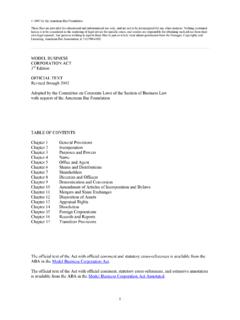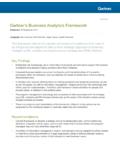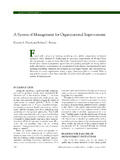Transcription of Organizational Controls as Enablers and Constraints in ...
1 1 Organizational Controls as Enablers and Constraints in Successful knowledge management Systems Implementation Reference: Malhotra, Y., Organizational Controls as Enablers and Constraints in Successful knowledge management Systems Implementation. In Y. Malhotra (Ed.), knowledge management and Business Model Innovation. Hershey, PA: Idea Group Publishing, 326-336, 2001. E-Mail: Web: Abstract: Many current implementations of Organizational knowledge management , although based on the most advanced information technologies, are hobbled by the pervading Organizational Controls . Such information systems related Organizational Controls could spell the success or failure of Organizational management initiatives despite application of latest groupware and collaboration software. Often, such failures of knowledge management systems implementations arise from incorrect understanding and misapplication of the notion of Controls . Hence, it is critical to develop a better understanding of information systems related Organizational Controls so that they can facilitate the success of knowledge management systems implementations.
2 This paper fills the critical void of incomplete and often incorrect interpretations of Organizational Controls by developing a better theoretical and conceptual understanding of Organizational Controls and their pragmatic implications. The paper also proposes an organic model of Organizational Controls for design of knowledge management systems that can effectively enable creation of new knowledge , renewal of existing knowledge and knowledge sharing. Keywords: knowledge management Systems, Organization Controls , Information Systems Implementation, knowledge Creation, knowledge Sharing 1. INTRODUCTION Despite advanced information systems that support rich information exchange and collaboration within the members of groups or organizations, many current implementations of knowledge management systems have shown limited success. Often the problems may not be with the design of such knowledge management systems, but their appropriation and effective utilization by the members of the organizations.
3 The key argument of this article is that information systems, when applied to knowledge management , are limited in their success by the pervading Organizational Controls . Often the notion of knowledge management is confused with the notion of controlling the members knowledge sharing behavior. A review of the literature on Organizational Controls suggests that this may be a dangerous and fallacious premise that may hobble the success of knowledge management systems implementations. In fact, a better understanding of Organizational Controls would suggest that 2 to mange is not to control. In other words, success of knowledge management systems could often result from propagating and nurturing the autonomy and self-control of organization members instead of exerting external influences to modify or manipulate their knowledge creating and knowledge sharing behavior. More importantly, in most cases, despite good design of information technology based architecture of knowledge management systems, attempting to modify or manipulate creating and knowledge sharing behavior may have result in the failure of knowledge management systems.
4 Section 2 provides a literature review about the concept of Organizational Controls . Section 3 discusses the limitations inherent in the mainstream model of knowledge management . Discussion in this section also expounds how inadequate understanding and application of Organizational Controls may often lead to failure of knowledge management implementations. Section 4 proposes and illustrates an organic model of Organizational Controls that is better suited to creation of new knowledge , renewal of existing knowledge and sharing of knowledge between the Organizational members. Based on the preceding discussion, section 5 underscores that knowledge management is as much of an oxymoron as any other related notions such as information systems management , human resource management , business management and so forth. 2. LITERATURE REVIEW ON Organizational Controls Despite lack of a commonly accepted framework or typology of Organizational Controls (Merchant and Simon 1986, Green & Welsh 1988, Simons 1990), invariably, most authors (cf.)
5 : Eisenhardt 1989, Flamholtz et al. 1985, Henderson & Lee 1992, Kirsch 1996, Lawler 1976, Orlikowski 1991b, Tannenbaum 1962) have interpreted control in terms of the influence exerted on the subordinates to seek their compliance with Organizational goals. Most such interpretations have used the thermostat analogy of the control system (cf.: Anthony 1988, Grant & Higgins 1991, Lawler & Rhode 1976). In most such thermostat models, performance 3 level of the subordinate is measured and compared with a pre-set standard and the subordinate acts on the feedback received from the superior to decrease the variance between the measured performance and the pre-defined standard. It has been assumed that the controller seeks compliance by exerting control, say in terms of pre-specified performance criteria, and the desired Organizational outcomes are achieved through compliance of the controllee.
6 In addition, it has also been assumed that Organizational outcomes resulting from the enforcement of compliance are generally favorable to the Organizational well-being. In most existing research and practice on knowledge management , such manipulation of behavior and actions of Organizational actors is treated in the context of utilization, processing, creation, dissemination and sharing of knowledge . Increasing awareness about the tacit or intrinsic knowledge of organization members (cf: Davenport and Prusak, 1997; CIO Enterprise 1999; Malhotra 1997, 1999e) has resulted in the premise that knowledge cannot be managed, , knowledge management is an oxymoron (cf: Information Week 1999, Computerworld 1998, Wall Street Journal 1998, Sveiby 1998). In addition, operational measures often recommended for facilitating knowledge management have included bonuses and incentives (cf: Davenport and Prusak, 1997) or other means of modifying or manipulating knowledge sharing behavior.
7 The dominant model of knowledge management based on control by compliance assumes that such operational measures would have a positive influence on knowledge creation and knowledge sharing behavior. However, a deeper understanding of Organizational Controls developed in this article suggests otherwise. 3. Controls THAT CONSTRAIN knowledge management Several conceptualizations of Organizational control have assumed alteration of the controllee's behavior (regulation) to be a direct consequence of the communication (feedback) from the controller. However, Giddens' (1984) notion of agency, known as the dialectic of control, recognizes that: "All forms of dependence offer some resources whereby those who are subordinate can influence the activities of their superiors." In other words, 4 assumption of the passive and compliant knowledge workers is inaccurate given that the controllee can "choose to do otherwise" (Giddens 1979, 1984, Orlikowski 1991a), despite attempts to manipulate or control one s knowledge sharing behavior.
8 Manz et al. (1987, p. 5) recognize controllee s choice between compliance and non-compliance in that observation that: "Persons may exercise self-control even when they choose to acquiesce to external demands, as acquiescence still implies choice." The active role of controllee in choosing between compliance and non-compliance has also received empirical support from more recent field studies conducted by Malhotra and Kirsch (1996) and Malhotra (1999a, 1999b). It is a different matter that in the world of re-everything (Arthur 1996), passive compliance to the status quo may be detrimental to the competitive health of the organization. Traditionally, Organizational Controls have been "built, a priori, on the principal of closure" (Landau & Stout 1979, p. 150) to seek compliance to, and convergence of, the Organizational decision-making processes (Flamholtz et al. 1985). The fundamental assumption underlying such Controls is that goals have been pre-decided, recipes for achieving those goals have been pre-decided and translated into procedural guidelines that need to be followed by the employees.
9 Such Organizational control systems were designed to reinforce stability and maintain the status quo. However, the cycle of doing "more of the same" tends to result in locked-in behavior patterns that eventually sacrifice Organizational performance at the altar of the Organizational "death spiral" (Nadler & Shaw 1995, p. 12-13). Hence, although knowledge management systems based on compliance may ensure conformity by enforcing task definition, measurement and control, yet they may inhibit creativity and initiative (Bartlett & Ghoshal 1995). Emphasis on the obedience of rules at the cost of correction of errors (Landau & Stout 1979) constrains creation of new knowledge and renewal of existing knowledge . The problem is compounded by incorrect assumptions about human knowledge underlying the currently popular notion of knowledge management systems that are supposedly expected to find useful knowledge , bottle 5 it, and pass it around (Hildebrand 1995; Stewart & Kaufman 1995).
10 Such representations often assume away the proactive role that knowledge workers need to play in the success of such systems (Newcombe 1999). knowledge needs to be understood as the potential for action that doesn t only depend upon the stored information but also on the individual interacting with it. The dominant conception of IS-based Organizational knowledge systems is constrained by the very nature of the knowledge creation processes: it ignores the dynamic and continuously evolving nature of knowledge ; it ignores the tacit and explicit dimensions of knowledge creation; it ignores the subjective, interpretative and meaning making bases of knowledge construction; it ignores the constructive nature of knowledge creation; and it ignores the social interactive basis of knowledge creation (Malhotra in press). The model of Organizational control embedded in such systems is also overwhelmed by the intense information flows required for (Bartlett & Ghoshal 1995): (a) keeping the centralized knowledge base and its custodians ( managers) continuously current with the discontinuously changing external environment, (b) continually updating the employees on the latest changes in their outputs (goals) and changes in procedures to achieve those outputs.







